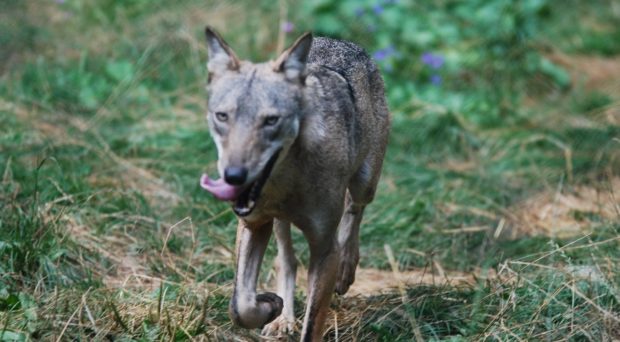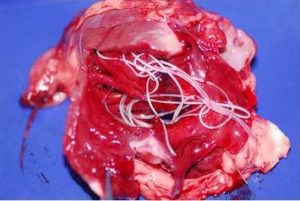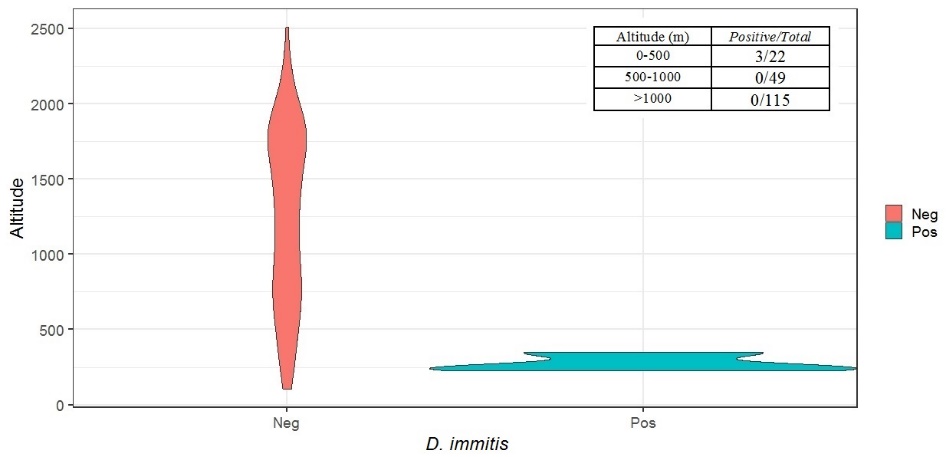
Our recent investigation on heartworms in a large wolf sample in Northern Italy revealed the competence of wolves as final hosts for this parasitic infection.
Heartworm Disease
Heartworm (HW) Disease is a parasitic infection caused by a large-sized nematode Dirofilaria immitis. It can affect dogs, and more rarely cats and ferrets, worldwide.

The life cycle of this parasite is strictly related to the distribution of the biological vectors, the mosquitoes, in which the development of the early life stages of D. immitis occur. To circulate in an area, the nematode also needs a competent final host.
The ideal final host for D. immitis should be an attractive prey for mosquitoes, but also a suitable incubator for the development of inoculated larvae till the adults form in the right heart. When individuals of both sexes are present, females produce blood circulating microfilariae that may be transmitted to mosquitoes during the blood meal.
Domestic dogs have always been considered the natural reservoir for D. immitis. But why shouldn’t wild canids be as suitable as their domestic counterparts?
Wildlife and D. immitis: reservoir or accidental host?
HW presence has been reported in several wild species.
Foxes and golden jackals were found to harbor the parasite in some Southern European countries, although microfilaremia (microfilariae in the bloodstream) was often low due to the rare occurrence of mature adults of both sexes.
However, HW infection has been poorly investigated in the grey wolf, a top predator currently in expansion in many European countries.
The return of wolves in Northern Italy
In the Alps, wolves were extirpated at the beginning of the XXth century due to uncontrolled hunting practices and made their return in the early 90’s. Since then, their population have been rapidly growing to a minimum of 300 individuals.
This rapid natural recolonization process has raised the attention of several eco-pathologists, as wolves are potential hosts for different zoonotic parasitic diseases. Moreover, the Italian Alps surround a large low-land area known to be hyperendemic for HW disease, which led to the question: will wolves be able to spread and maintain D. immitis infection independently of infected dogs?
Prevalence and fertility analysis of D. immitis in wolves
To unravel this pillar stone, a study was conducted at the Veterinary School of Turin in Northern Italy, where 210 carcasses of wolves were inspected across 2001-2019 for the presence of HWs.
Three wolves resulted positive (prevalence: 1.4%). They originated from a single province, where HW disease is commonly found in untreated dogs.
How to verify the competence of wolves as host for HWs?
Assessing the reservoir capacity of a specific host for a parasitic infection is a complex task, as not only the persistence of the parasite has to be proved, but also its ability to successfully reproduce and complete the life cycle.
The fertility of D. immitis specimens from wolves was carried out by the “embryogram” technique, which consists in cutting and squeezing out the uterine content of adult females in order to count the embryonic stages in each segment and evaluate their progressive development along the uterus.

Should vets be worried?
Since wolves are the ancestors of domestic dogs, and they belong to the same species (Canis lupus), our results were predictable.
But there is more to consider: the habitat of the two canids.
Grey wolves in Southern Europe are mainly mountain-hill dwelling animals, while owned dogs have a human-mediated distribution.
Accordingly, the spatial overlapping between wolves, owned dogs and dense mosquito populations (usually found at lower elevations) has remained relatively rare.

However, the epidemiological situation could rapidly evolve, since “alpine” wolves are increasingly dispersing to lower elevations and more anthropized areas and, in turn, global warming is favoring the altitudinal spread of mosquitoes and mosquito-transmitted diseases, including HW. Careful monitoring is therefore advisable.

Comments